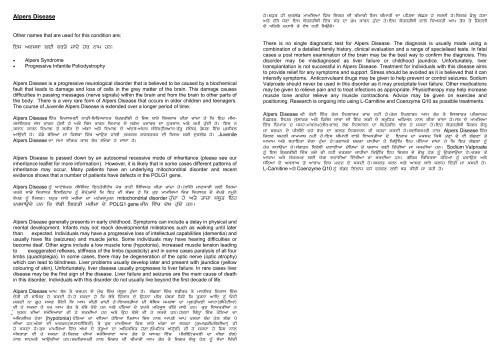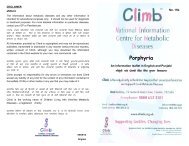Alpers Disease - Children Living with Inherited Metabolic Diseases
Alpers Disease - Children Living with Inherited Metabolic Diseases
Alpers Disease - Children Living with Inherited Metabolic Diseases
Create successful ePaper yourself
Turn your PDF publications into a flip-book with our unique Google optimized e-Paper software.
<strong>Alpers</strong> <strong>Disease</strong><br />
Other names that are used for this condition are:<br />
fJ; nt;Ek bJh tos/ ik_d/ j'o Bkw jBL<br />
<br />
<br />
<strong>Alpers</strong> Syndrome<br />
Progressive Infantile Poliodystrophy<br />
<strong>Alpers</strong> <strong>Disease</strong> is a progressive neurological disorder that is believed to be caused by a biochemical<br />
fault that leads to damage and loss of cells in the grey matter of the brain. This damage causes<br />
difficulties in passing messages (nerve signals) <strong>with</strong>in the brain and from the brain to other parts of<br />
the body. There is a very rare form of <strong>Alpers</strong> <strong>Disease</strong> that occurs in older children and teenagers.<br />
The course of Juvenile <strong>Alpers</strong> <strong>Disease</strong> is extended over a longer period of time.<br />
<strong>Alpers</strong> <strong>Disease</strong> fJZe ftek;wJh BkVh-ftfrnkBe p/soshph j? fi; pko/ ftµtkµ ehsk ik_dk j? fe fJj ihto;kfJDe<br />
d'µ ekoB j[zdh j? ns/ fi; ekoB fdwkr d/ ;c?d gdkoE dk B[e;kB ns/ ewh j[zdh j?. fJ; B<br />
[e;kB ekoB fdwkr s'_ ;oho d/ nzrk_ ns/ fdwkr d/ nzdo'-nzdo ;zd/µ(frnkB-szs{ ;zd/µ) G/iD ftZu w[µfeb<br />
nkT[_dh j?. tZv/ pZfunk_ ik_ feµ'ok_ ftZu nkT[D tkbh <strong>Alpers</strong> <strong>Disease</strong> dh fe;w pVh d[obZG j?. Juvenile<br />
<strong>Alpers</strong> <strong>Disease</strong> dk ;wk_ dhox ekb sZe bzw/ok j' ik_dk j?.<br />
<strong>Alpers</strong> <strong>Disease</strong> is passed down by an autosomal recessive mode of inheritance (please see our<br />
inheritance leaflet for more information). However, it is likely that in some cases different patterns of<br />
inheritance may occur. Many patients have an underlying mitochondrial disorder and recent<br />
evidence shows that a number of patients have defects in the POLG1 gene.<br />
j?.pj[s jh d[obZG wkwfbnk_ ftZu firo dh phwkoh fJ; phwkoh dk gfjbk bZSD j' ;edh j?.firo c/bQ j'Dk<br />
ns/ d"o/ g?Dk fJ; p/soshph ftZu w"s dk w[ Zy ekoB j[zdk j?.fJ; p/soshph tkb/ ftnesh nkw s"o s/ f—zdrh<br />
d/ gfjb/ djke/ s'_ tZX Bjh_ fiT[_d/.<br />
There is no single diagnostic test for <strong>Alpers</strong> <strong>Disease</strong>. The diagnosis is usually made using a<br />
combination of a detailed family history, clinical evaluation and a range of specialised tests. In fatal<br />
cases a post mortem examination of the brain may be the best way to confirm the diagnosis. This<br />
disorder may be misdiagnosed as liver failure or childhood jaundice. Unfortunately, liver<br />
transplantation is not successful in <strong>Alpers</strong> <strong>Disease</strong>. Treatment for individuals <strong>with</strong> this disease aims<br />
to provide relief for any symptoms and support. Stress should be avoided as it is believed that it can<br />
intensify symptoms. Anticonvulsant drugs may be given to help prevent or control seizures. Sodium<br />
Valproate should never be used in this disorder as it may precipitate liver failure. Other medications<br />
may be given to relieve pain and to treat infections as appropriate. Physiotherapy may help increase<br />
muscle tone and/or relieve any muscle contractions. Advice may be given on exercise and<br />
positioning. Research is ongoing into using L-Carnitine and Coenzyme Q10 as possible treatments.<br />
<strong>Alpers</strong> <strong>Disease</strong> dh e'Jh fJZe o'r fBoXkoe ik_u Bjh_ j?.o'r fBoXkoB nkw s"o s/ ft;Ekos gfotkoe<br />
fgS'eV, f;js w[Zbk_eD ns/ ftµ/µ ik_uk_ dh fJZe bVh d/ ;w{fje nfXn?B Bkb ehsk ik_dk j?.w"s d/ wkwfbnk_<br />
ftZu fdwkr d g';N-wkoNw(uho-ckV) o'r fBoXkoB dk p/jsohB Yzr j' ;edk j?.fJj p/soshph firo c/bQ<br />
ik_ pugB d/ ghbhJ/ ti'_ o'r dk rbs fBoµkoB th eotk ;edh j?.pdfe;wsh Bkb <strong>Alpers</strong> <strong>Disease</strong> ftZu<br />
firo pdbh ekw:kp Bjh_ j?.fJ; phwkoh tkb/ ftneshnk_ d/ fJbki dk we;d fe;/ soQk_ d/ th bZSDk_ s'_<br />
nkokw ns/ ;jkfJsk d/Dk j[zdk j?.sDkns'_ puDk ukjhdk j? feT[_fe fJj wzfBnk ik_dk j? fe fJj bZSDk_ B{z<br />
j'o tXkT[_dk j?.;zrVB fto'Xh dtkJhnk_ d"fonk_ s'_ pukn bJh fdZshnk_ ik ;edhnk_ jB. Sodium Valproate<br />
B{z fJ; p/soshph ftZu ed/ th Bjh_ tosDk ukjhdk feT[_fe fJj firo d/ c/bQ j'D B{z T[e;kT[_dk j?.dod s'_<br />
nkokw ns/ ;zeowD bJh :'r dtkJhnk_ fdZshnk_ ik ;edhnk_ jB. G"fse fufes;k gZfmnk_ B{z tXkT[D ns/<br />
gZfmnk_ d/ neVkn s'_ nkokw ftu wdd d/ ;edh j?.e;os eoB ns/ nk;D pko/ ;bkj fdZsh ik e;dh j?.<br />
L-Carnitine ns/ Coenzyme Q10 B{z ;zGt fJbki ti'_ tosD bJh y'i ehsh ik ojh j?.<br />
<strong>Alpers</strong> <strong>Disease</strong> B{z nkN';'wb oh;?f;t fJBj?ohN?_; w'v okjh_ f;Zfyns ehsk ik_dk j?.(tX/o/ ikDekoh bJh feogk<br />
eoe/ ;kv/ ftok;s fJµfsjko B{z t/y')Gk_t/_ fe fJj th ;zGt j? fe e[M wkwfbnk_ ftu ftok;s d/ tZyo/ Bw{B/<br />
t/yD B{z fwbD. pj[s ;ko/ woh—k_ dk wjZstg{oB mitochondrial disorder j[zdk j? ns/ sk—k ;p{s fJj<br />
do;kT[_d/ jB fe tZvh frDsh woh—k_ d/ POLG1 gene ihB ftZu d'µ j[zd/ jB.<br />
<strong>Alpers</strong> <strong>Disease</strong> generally presents in early childhood. Symptoms can include a delay in physical and<br />
mental development. Infants may not reach developmental milestones such as walking until later<br />
than expected. Individuals may have a progressive loss of intellectual capabilities (dementia) and<br />
usually have fits (seizures) and muscle jerks. Some individuals may have hearing difficulties or<br />
become deaf. Other signs include a low muscle tone (hypotonia), increased muscle tension leading<br />
to exaggerated reflexes, stiffness of the limbs (spasticity) and in some cases paralysis of all four<br />
limbs (quadriplegia). In some cases, there may be degeneration of the optic nerve (optic atrophy)<br />
which can lead to blindness. Liver problems usually develop later and present <strong>with</strong> jaundice (yellow<br />
colouring of skin). Unfortunately, liver disease usually progresses to liver failure. In rare cases liver<br />
disease may be the first sign of the disease. Liver failure and seizures are the main cause of death<br />
in this disorder. Individuals <strong>with</strong> this disorder do not usually live beyond the first decade of life.<br />
<strong>Alpers</strong> <strong>Disease</strong> nkw s"o s/ pugB d/ w[ ZY ftZu w"i{d j[zdk j?. bZSDk_ ftZu ;ohoe s/ wkBf;e ftek; ftZu<br />
d/oh th µkfwb j' ;edh j?.j' ;edk j? fe pZu/ ftZek; d/ T[jBk_ whb gZEok_ fit/_ fe s[oBk nkfd B{z UBh<br />
ibdh Bk S{j ;eD fizBh fe nk; ehsh ik_dh j?.ftneshnk_ dh p"fXe ;woEk dk gqrshwJh xkNk(vhw?_Nhnk)<br />
th j' ;edk j? go nkw s"o s/ d"o/ g?_d/ jB ns/ gfZmnk_ d/ MNe/ wfj;{; ehs/ ik_d/ jB. e[M ftneshnk_ B<br />
{z ;[DB dhnk_ ;wZf;nk_tk_ th j' ;edhnk_ jB ns/ T[j p'b/ th j' ;ed/ jB.j'oBk_ fuzBQk_ ftZu gZfmnk_ dk<br />
nftef;s j'Dk (hypotonia) gZfmnk_ dk tfXnk j'fJnk fyukn fi; Bkb nkgD/ nkg gbek_ pzd j'D bZr g?<br />
_dhnk_ jB,nzrk_ dh neVB(;gk;Nhf;Nh) s/ e[M wkwfbnk_ ftu uko/ nzrk_ dk betk (e[nkvohgb/rhnk) th<br />
j' ;edk j?.e[M wkwfbnk_ ftZu nZyk_ d/ szs{nk_ dk nftef;s j'Dk,(UgfNe n?Nq"ch) th j' ;edk j? fi; Bkb<br />
nzXoksk th j' ;edk j?.firo dhnk_ ;wZf;nk_tk_ nkw s"o s/ pknd ftZu ghbhJ/(uwVh dk ghbk ozr)<br />
Bkb ;kjwD/ nkT[_dhnk_ jB.pdfe;wsh Bkb firo dh phwkoh nkw s"o s/ firo c/bQ j'D B{z ;Zdk fdzdh




